2001 AUDI A4 window
[x] Cancel search: windowPage 10 of 88
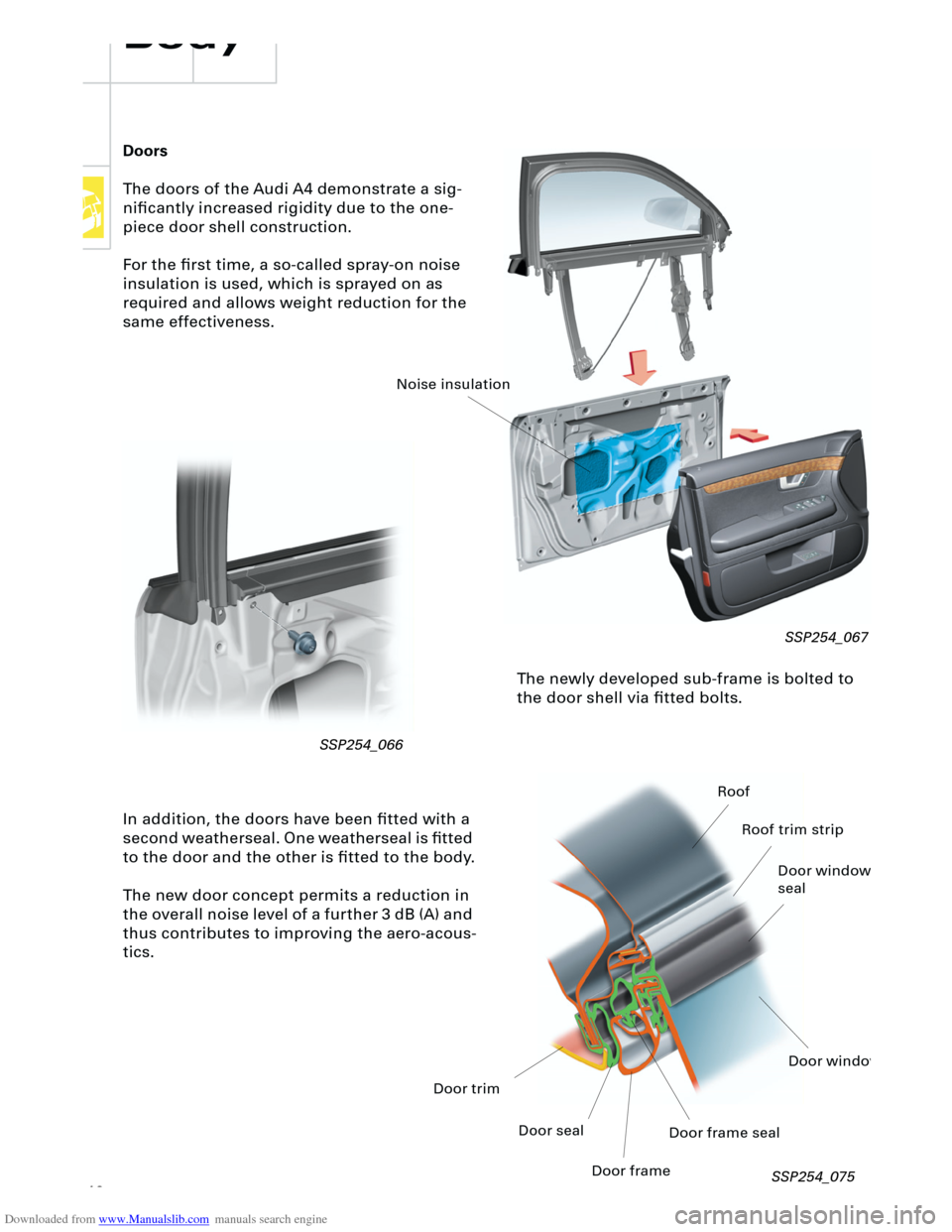
Downloaded from www.Manualslib.com manuals search engine
10
Body
Doors
The doors of the Audi A4 demonstrate a sig-
nificantly increased rigidity due to the one-
piece door shell construction.
For the first time, a so-called spray-on noise
insulation is used, which is sprayed on as
required and allows weight reduction for the
same effectiveness.
The newly developed sub-frame is bolted to
the door shell via fitted bolts.
In addition, the doors have been fitted with a
second weatherseal. One weatherseal is fitted
to the door and the other is fitted to the body.
The new door concept permits a reduction in
the overall noise level of a further 3 dB (A) and
thus contributes to improving the aero-acous-
tics.
SSP254_066
SSP254_075SSP254_067
Noise insulation
Roof trim strip
Door window
seal
Door windo
w
Door frameDoor frame seal
Door trim
Door sealRoof
Page 59 of 88
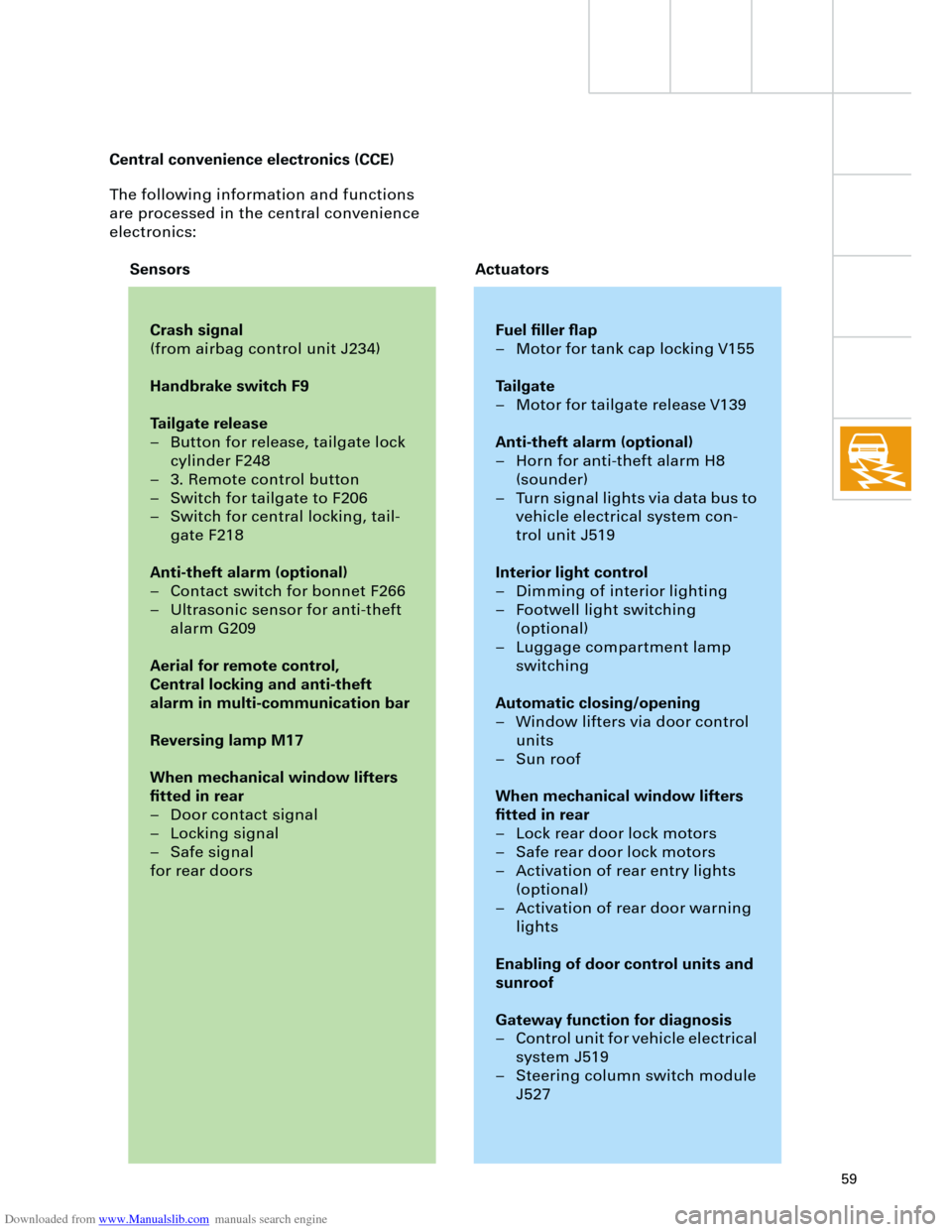
Downloaded from www.Manualslib.com manuals search engine
59
The following information and functions
are processed in the central convenience
electronics:
Crash signal
(from airbag control unit J234)
Handbrake switch F9
Tailgate release
– Button for release, tailgate lock
cylinder F248
– 3. Remote control button
– Switch for tailgate to F206
– Switch for central locking, tail-
gate F218
Anti-theft alarm (optional)
– Contact switch for bonnet F266
– Ultrasonic sensor for anti-theft
alarm G209
Aerial for remote control,
Central locking and anti-theft
alarm in multi-communication bar
Reversing lamp M17
When mechanical window lifters
fitted in rear
– Door contact signal
– Locking signal
– Safe signal
for rear doors
Fuel filler flap
– Motor for tank cap locking V155
Tailgate
– Motor for tailgate release V139
Anti-theft alarm (optional)
– Horn for anti-theft alarm H8
(sounder)
– Turn signal lights via data bus to
vehicle electrical system con-
trol unit J519
Interior light control
– Dimming of interior lighting
– Footwell light switching
(optional)
– Luggage compartment lamp
switching
Automatic closing/opening
– Window lifters via door control
units
– Sun roof
When mechanical window lifters
fitted in rear
– Lock rear door lock motors
– Safe rear door lock motors
– Activation of rear entry lights
(optional)
– Activation of rear door warning
lights
Enabling of door control units and
sunroof
Gateway function for diagnosis
– Control unit for vehicle electrical
system J519
– Steering column switch module
J527
Sensors Actuators Central convenience electronics (CCE)
Page 60 of 88
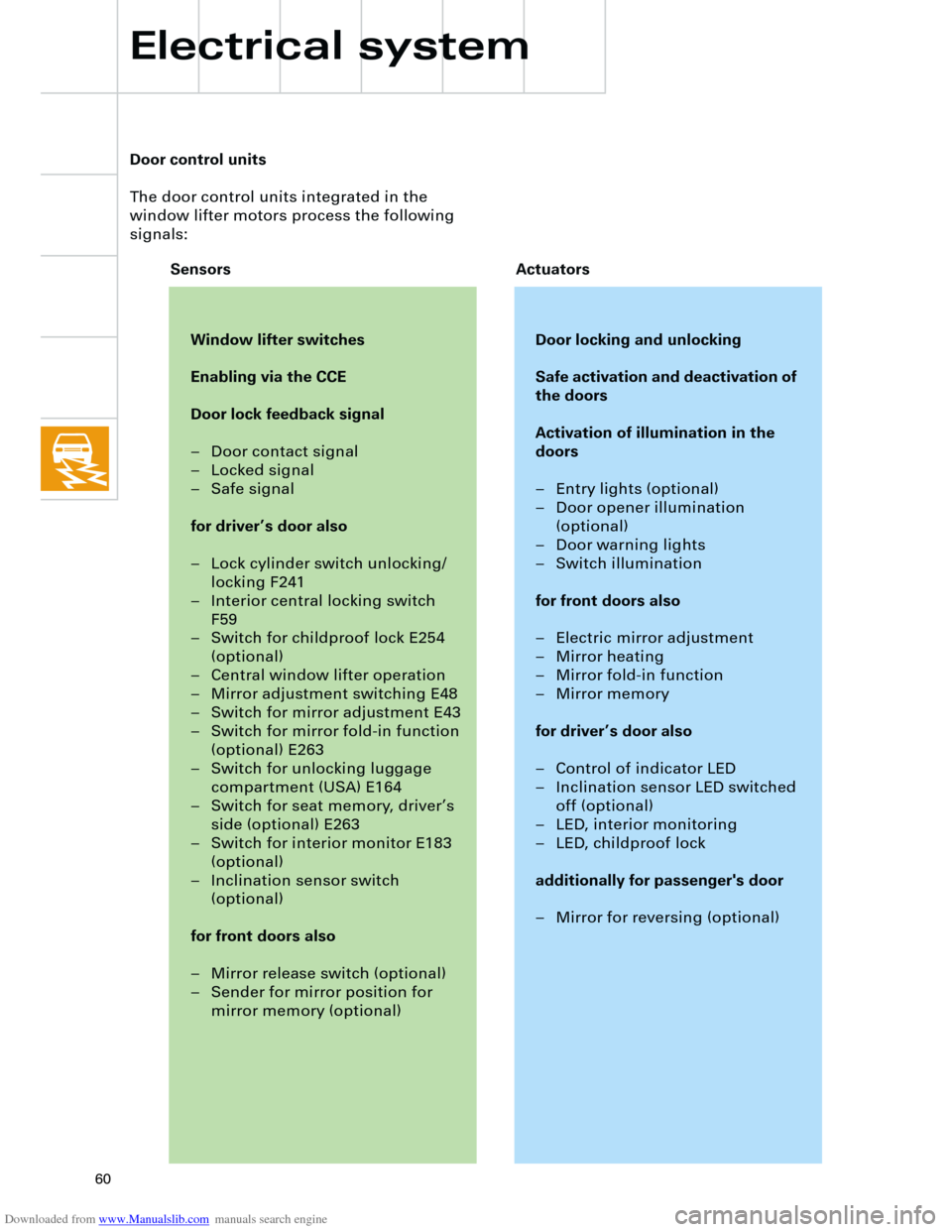
Downloaded from www.Manualslib.com manuals search engine
60
Door control units
The door control units integrated in the
window lifter motors process the following
signals:
Window lifter switches
Enabling via the CCE
Door lock feedback signal
– Door contact signal
– Locked signal
– Safe signal
for driver’s door also
– Lock cylinder switch unlocking/
locking F241
– Interior central locking switch
F59
– Switch for childproof lock E254
(optional)
– Central window lifter operation
– Mirror adjustment switching E48
– Switch for mirror adjustment E43
– Switch for mirror fold-in function
(optional) E263
– Switch for unlocking luggage
compartment (USA) E164
– Switch for seat memory, driver’s
side (optional) E263
– Switch for interior monitor E183
(optional)
– Inclination sensor switch
(optional)
for front doors also
– Mirror release switch (optional)
– Sender for mirror position for
mirror memory (optional)
Door locking and unlocking
Safe activation and deactivation of
the doors
Activation of illumination in the
doors
– Entry lights (optional)
– Door opener illumination
(optional)
– Door warning lights
– Switch illumination
for front doors also
– Electric mirror adjustment
– Mirror heating
– Mirror fold-in function
– Mirror memory
for driver’s door also
– Control of indicator LED
– Inclination sensor LED switched
off (optional)
– LED, interior monitoring
– LED, childproof lock
additionally for passenger's door
– Mirror for reversing (optional)
Sensors Actuators
Electrical system
Page 61 of 88
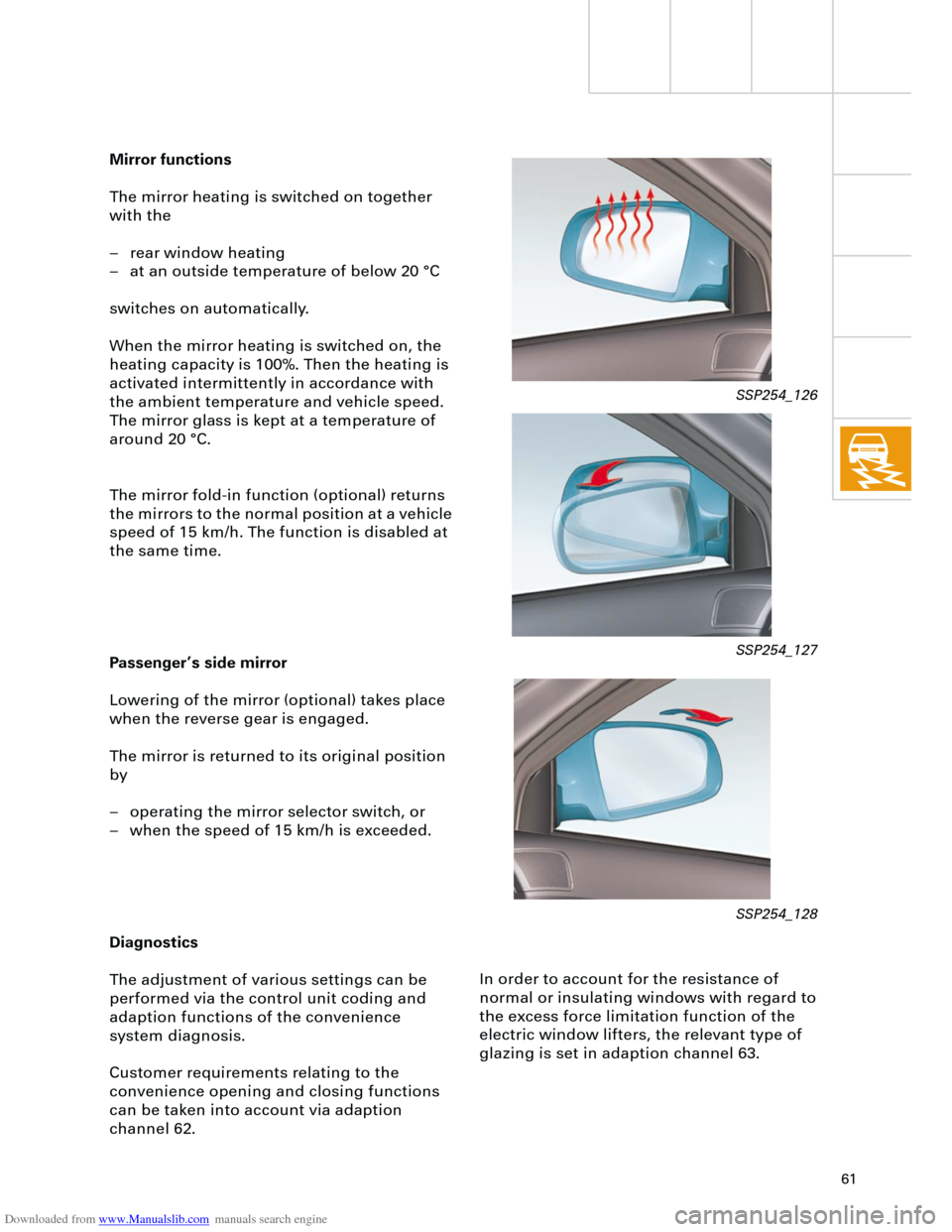
Downloaded from www.Manualslib.com manuals search engine
61
In order to account for the resistance of
normal or insulating windows with regard to
the excess force limitation function of the
electric window lifters, the relevant type of
glazing is set in adaption channel 63.
Mirror functions
The mirror heating is switched on together
with the
– rear window heating
– at an outside temperature of below 20 °C
switches on automatically.
When the mirror heating is switched on, the
heating capacity is 100%. Then the heating is
activated intermittently in accordance with
the ambient temperature and vehicle speed.
The mirror glass is kept at a temperature of
around 20 °C.
The mirror fold-in function (optional) returns
the mirrors to the normal position at a vehicle
speed of 15 km/h. The function is disabled at
the same time.
Passenger’s side mirror
Lowering of the mirror (optional) takes place
when the reverse gear is engaged.
The mirror is returned to its original position
by
– operating the mirror selector switch, or
– when the speed of 15 km/h is exceeded.
Diagnostics
The adjustment of various settings can be
performed via the control unit coding and
adaption functions of the convenience
system diagnosis.
Customer requirements relating to the
convenience opening and closing functions
can be taken into account via adaption
channel 62.
SSP254_126
SSP254_127
SSP254_128
Page 72 of 88

Downloaded from www.Manualslib.com manuals search engine
72
TS
TS
Multi-communication bar (MCB)
The Audi A4 Saloon features the multi-com-
munication bar in the top part of the rear win-
dow for the first time.
The
– aerial module,
– aerial for navigation system (GPS),+
– and aerial for telephone (GSM)
are fitted in the MCB.
The
– aerial diversity,
– aerial amplifier for the four radio aerials
(FM1-4, AM),
– 4 aerial amplifiers for the TV aerials 1-4,
– aerial for radio remote control, central lock-
ing (RCL),
– and the aerial for the telestart function (TS)
of the auxiliary heating
are integrated in the aerial module.
The aerial conductor is located in the rear
window. The electrical connection between
the aerial amplifier and the conductor on the
rear window is made by means of spring
contacts.
Both the GPS and the GSM aerials are also
fitted in the top edge of the rear window, but
these are not connected by means of conduc-
tors in the rear window.
Thanks to this compact arrangement, no
aerials are visible from outside.
The emergency aerial for the telematics is
located at the rear bumper.
Electrical system
SSP254_109
SSP254_013
GSMGPS
Aerial module
Normal glazing
Insulating glazing
Page 80 of 88
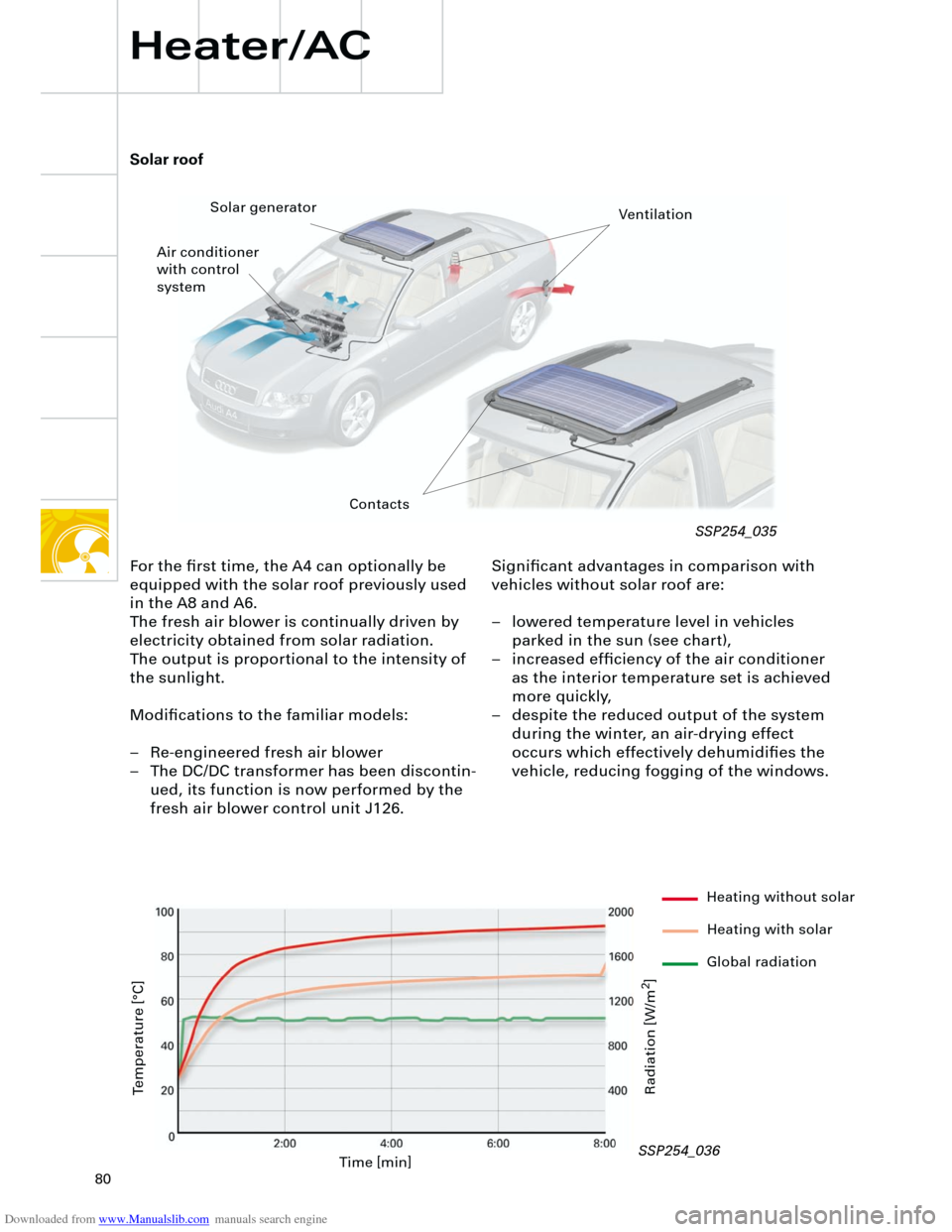
Downloaded from www.Manualslib.com manuals search engine
80
Heater/AC
Significant advantages in comparison with
vehicles without solar roof are:
– lowered temperature level in vehicles
parked in the sun (see chart),
– increased efficiency of the air conditioner
as the interior temperature set is achieved
more quickly,
– despite the reduced output of the system
during the winter, an air-drying effect
occurs which effectively dehumidifies the
vehicle, reducing fogging of the windows.
Solar roof
For the first time, the A4 can optionally be
equipped with the solar roof previously used
in the A8 and A6.
The fresh air blower is continually driven by
electricity obtained from solar radiation.
The output is proportional to the intensity of
the sunlight.
Modifications to the familiar models:
– Re-engineered fresh air blower
– The DC/DC transformer has been discontin-
ued, its function is now performed by the
fresh air blower control unit J126.
Time [min]
Temperature [°C]
Radiation [W/m
2
]
Ventilation
Air conditioner
with control
systemSolar generator
SSP254_035
SSP254_036
Contacts
Heating without solar
Heating with solar
Global radiation
Page 84 of 88
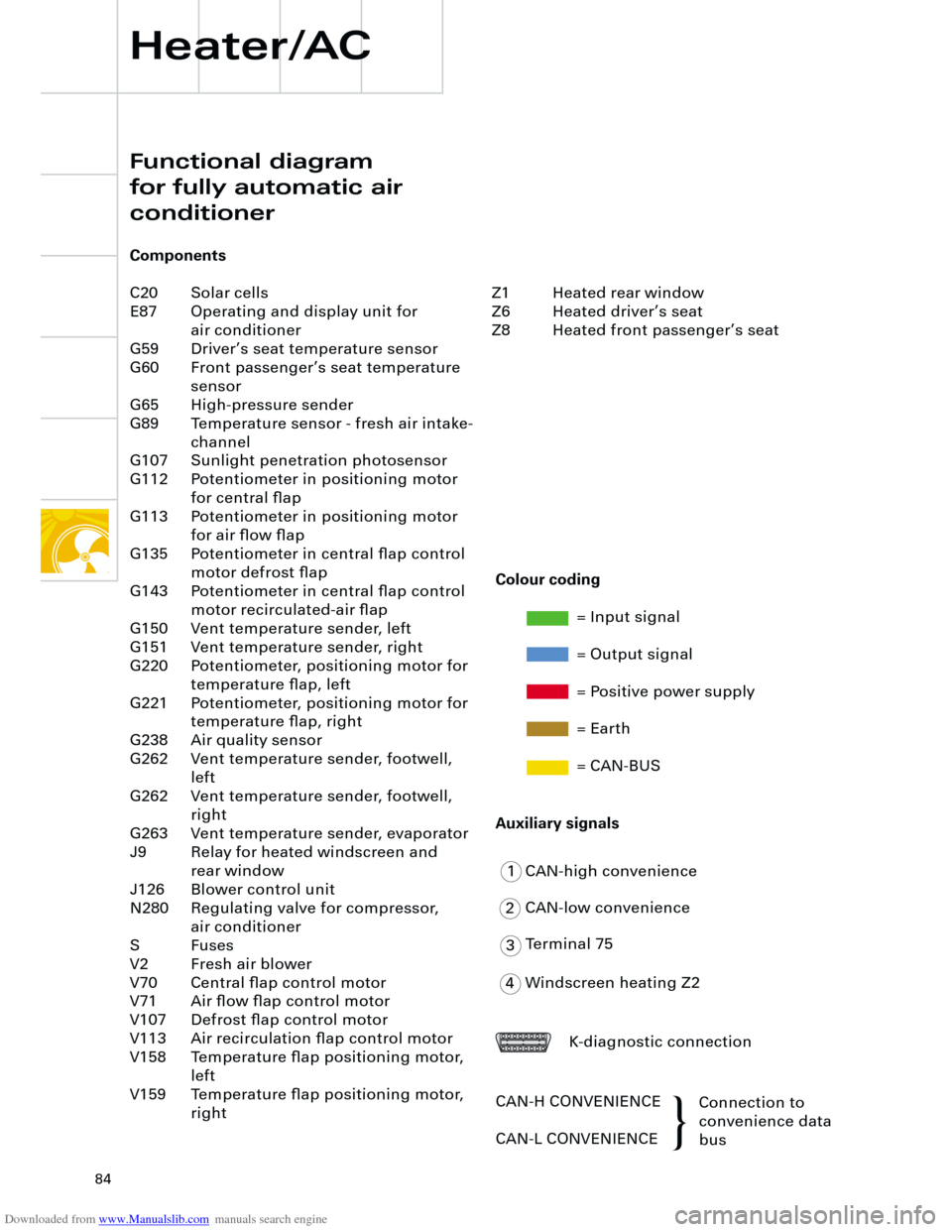
Downloaded from www.Manualslib.com manuals search engine
84
Heater/AC
Functional diagram
for fully automatic air
conditioner
Components
C20 Solar cells
E87 Operating and display unit for
air conditioner
G59 Driver’s seat temperature sensor
G60 Front passenger’s seat temperature
sensor
G65 High-pressure sender
G89 Temperature sensor - fresh air intake-
channel
G107 Sunlight penetration photosensor
G112 Potentiometer in positioning motor
for central flap
G113 Potentiometer in positioning motor
for air flow flap
G135 Potentiometer in central flap control
motor defrost flap
G143 Potentiometer in central flap control
motor recirculated-air flap
G150 Vent temperature sender, left
G151 Vent temperature sender, right
G220 Potentiometer, positioning motor for
temperature flap, left
G221 Potentiometer, positioning motor for
temperature flap, right
G238 Air quality sensor
G262 Vent temperature sender, footwell,
left
G262 Vent temperature sender, footwell,
right
G263 Vent temperature sender, evaporator
J9 Relay for heated windscreen and
rear window
J126 Blower control unit
N280 Regulating valve for compressor,
air conditioner
S Fuses
V2 Fresh air blower
V70 Central flap control motor
V71 Air flow flap control motor
V107 Defrost flap control motor
V113 Air recirculation flap control motor
V158 Temperature flap positioning motor,
left
V159 Temperature flap positioning motor,
right
1
2
3
4CAN-high convenience
CAN-low convenience
Terminal 75
Windscreen heating Z2
K-diagnostic connection
CAN-H CONVENIENCE
CAN-L CONVENIENCEConnection to
convenience data
bus
Colour coding
= Input signal
= Output signal
= Positive power supply
= Earth
= CAN-BUS
Auxiliary signals
Z1 Heated rear window
Z6 Heated driver’s seat
Z8 Heated front passenger’s seat
{